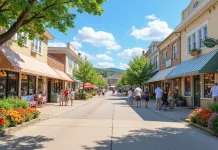Discovering America’s Underrated Wine Regions
America is widely known for its prestigious wine regions such as Napa Valley and Sonoma County. However, there are some incredible and lesser-known wine regions across the United States waiting to be discovered. These regions offer unique experiences, diverse varietals, and intimate settings that wine enthusiasts will truly appreciate. Let’s journey through some of these hidden gems.
Virginia’s Charming Vineyards
Lush Landscapes and Historical Roots
Virginia might not be the first place that comes to mind when you think of wine, but it’s a region with deep historical roots and stunning landscapes. Nestled in the heart of the Blue Ridge Mountains, Virginia boasts over 200 wineries producing an array of varietals, from hearty reds to crisp whites.
Thomas Jefferson’s Wine Legacy
The connection to wine in Virginia dates back to Thomas Jefferson, America’s third president, who envisioned this state becoming a wine powerhouse. He never saw the fruits of his labor, but his dream is alive today with the Monticello Wine Trail, which features more than 30 wineries near his historic home.
Distinct Varietals
Virginia wineries are known for producing Viognier, often referred to as the state’s signature white wine. It’s a full-bodied wine that offers notes of stone fruits and floral aromas. On the red side, Virginia excels with Cabernet Franc, known for its peppery and fruity profile.
The Texas Hill Country
Big Flavors from the Lone Star State
Everything’s bigger and, in many cases, better in Texas, and that includes its wine. As the second-largest producer of wine in the U.S., the Texas Hill Country is emerging as a prominent player. The wide range of microclimates in this region allows for a plethora of varietals to thrive.
A Diverse Selection of Wines
From Tempranillo to Mourvèdre, the wines in the Texas Hill Country are as varied as the landscape. Tempranillo, in particular, has found a happy home here, with its bold, fruity character complemented by the Texas sun. This makes it a must-try for red wine aficionados exploring the area.
Winery Experiences
In addition to fantastic wines, the Hill Country offers unique winery experiences, with many vineyards hosting music events, wine pairing dinners, and immersive tastings that showcase Texan culture and hospitality.
New York’s Finger Lakes Region
A Cool Climate Haven
The cool climate of New York’s Finger Lakes region is ideal for growing classic European grape varieties. With over a hundred wineries, this area is renowned for its Riesling, which thrives in the area’s slate-rich soils and lake-moderated weather.
Riesling: The Star of Finger Lakes
Finger Lakes Rieslings are celebrated for their floral notes, crisp acidity, and varying levels of sweetness. They reflect the terroir beautifully and offer a taste that’s both refreshing and complex.
Pioneers in Sustainability
This region isn't just about exceptional wines; it’s also leading the way in sustainable winemaking practices. Many Finger Lakes wineries are committed to organic farming, reducing carbon footprints, and preserving the natural beauty of the area.
Michigan’s Wine Coast: Traverse City
Overlooked Potential in the Midwest
Northern Michigan, particularly around Traverse City, offers an idyllic backdrop for wine production. With its rolling hills and proximity to Lake Michigan, it’s a region that surprises and delights its visitors with an array of classic and hybrid varietals.
Perfect Pinot Gris and Cabernet Franc
Michigan’s wine country is particularly noted for its vibrant Pinot Gris and balanced Cabernet Franc. The cool climate is perfect for preserving acidity and creating wines that are lively and full of character.
Seasonal Attractions
From cherry festivals to beautiful foliage in the fall, the Traverse City region offers a feast for the senses year-round. Wineries often host seasonal events that pair local foods with their latest releases, enhancing the connection between the land and its produce.
The Idyllic Willamette Valley, Oregon
A Pinot Noir Paradise
While Oregon is gaining recognition for its exceptional Pinot Noir, the Willamette Valley still remains underrated compared to California’s famous regions. This valley is home to over 500 wineries and is blessed with a climate and soil that resembles Burgundy, France.
Pinot Noir’s Sublime Quality
Willamette Valley Pinot Noir is known for its elegance, with flavors of cherry, strawberry, and earthy undertones. These wines are often lighter than their Californian counterparts but carry a complexity and depth that is truly captivating.
Commitment to Organic Practices
A significant portion of Willamette Valley wine producers are devoted to organic and biodynamic practices, ensuring the preservation of the environment and the high quality of their wines.
The Deserts and Beyond: Arizona’s Wine Scene
A Surprising Oasis of Flavor
Arizona, predominantly known for its arid landscapes, might surprise you with its burgeoning wine scene. The high deserts and mountain foothills provide an ideal climate for growing grapes, resulting in distinctive wines that capture the rugged beauty of the state.
Rhône Varietals Take Center Stage
Arizona is carving out a niche with Rhône varietals, including Grenache, Syrah, and Mourvèdre. These grapes thrive in the warm sun during the day and cool nights, producing rich and robust wines.
Growing Community of Vintners
The community of Arizona winemakers is tight-knit and collaborative, often banding together to promote the region’s wine culture through festivals, tastings, and educational events that encourage locals and visitors alike to appreciate what Arizona has to offer.
South Carolina’s Up-and-Coming Scene
Sandy Soils and Southern Charm
South Carolina might not yet be on the wine map, but with its rich soil and long growing season, this region is starting to attract attention. Particularly around the Charleston area, you can find burgeoning vineyards experimenting with classic and local varietals.
A Nod to Native Grapes
While still in its infancy, the South Carolina wine industry embraces native grapes like Muscadine, which produce sweet, aromatic wines that reflect Southern heritage. There's also increasing experimentation with varietals like Cabernet Sauvignon and Chardonnay, mirroring more established wine regions.
Local Flare and Wine Festivals
Pairing wine with Southern cuisine is becoming increasingly popular, with local flare featuring prominently at wine festivals. These events often highlight local musicians, food vendors, and, of course, the up-and-coming wines that South Carolina is proud to showcase.
Idaho’s Secret: The Wine Lovers’ Playground
An Unexpected Treasure
Idaho is often associated more with potatoes than vineyards, but the state is home to a rapidly growing wine industry. The Snake River Valley is Idaho’s prime wine region, characterized by its warm days, cool nights, and volcanic soil.
Balanced Reds and Crisp Whites
Idaho wine producers excel in creating beautifully balanced Syrahs and Viogniers, with the volcanic soil contributing to the unique flavor profiles of these wines. Other varietals like Malbec and Merlot are also making their mark in this evolving landscape.
Personalized Wine Experiences
Many Idaho wineries are family-owned and offer personalized wine-tasting experiences. Visitors can enjoy intimate tours and tastings, often conducted by the vintners themselves, providing a deeper education and appreciation of the wines produced here.
North Carolina’s Yadkin Valley
A Region Steeped in Tradition
North Carolina’s wine industry has blossomed over the past few decades, particularly in the Yadkin Valley. This area, with its gentle hills and temperate climate, has become the epicenter of North Carolina winemaking.
Diverse Wine Offerings
The Yadkin Valley produces a variety of wines, with Sangiovese, Merlot, and Chardonnay standing out. These wines often display a unique combination of traditional European styles fused with the distinctive flavors imparted by the local terroir.
Community Events and Festivals
The vibrant local wine community organizes numerous festivals and events throughout the year, celebrating the local food and wine. These gatherings are a great way to savor the region's offerings and experience the warm hospitality that North Carolina is famous for.
Colorado’s High Altitude Wines
Wines with a View
Nestled among the Rocky Mountains, Colorado's wine regions offer not only great wine but breathtaking scenery. The high altitude and unique climate conditions create a perfect environment for growing a variety of grape types.
Altitude Influenced Flavors
Colorado wineries are known for producing crisp whites like Chardonnay and Sauvignon Blanc, as well as robust reds such as Merlot and Cabernet Sauvignon. The altitude contributes to the wines' flavor profiles, imparting a freshness and a distinctive minerality.
Adventure and Wine
Many Colorado wineries embrace the adventurous spirit of the state, offering wine-tasting experiences that include hiking, biking, or even horseback riding through the vineyards, making for a truly memorable visit.
Wisconsin’s Unexpected Vineyards
A Midwest Surprise
Not typically known for wine, Wisconsin offers unexpected delights with its burgeoning vineyards. The state provides a hospitable environment for cold-hardy grape varieties, thanks in part to its distinct growing season influenced by the Great Lakes.
Cold-Hardy Varietals Lead the Way
In Wisconsin, varietals like Marquette and Frontenac are popular. These cold-hardy grapes produce wines with bright acidity and intense fruit flavors, perfectly suited for the state’s cooler climate.
A Community of Craftsmanship
Wisconsin’s wine industry is characterized by a spirit of craftsmanship and innovation. Many wineries are focused on producing small-batch wines that highlight the state’s unique terroir, offering visitors a taste of true Wisconsin hospitality and ingenuity.
Exploring Across Borders: New Mexico’s Wine Scene
A Historic and Artistic Approach
With a winemaking history that dates back to the 1600s, New Mexico offers a unique blend of tradition and modern innovation. The state's diverse geography, ranging from high deserts to low river valleys, supports a wide variety of grape cultivation.
Vibrant Varietals and Innovations
New Mexico is known for its sparkling wines crafted in the traditional French method, as well as full-bodied reds like Syrah and Zinfandel. These wines capture the essence of the state’s rich history and innovative spirit.
Culture Meets Viticulture
In New Mexico, wine is intertwined with art, music, and culture. Wineries frequently incorporate local artists and musicians into the wine-tasting experience, creating an atmosphere that celebrates the cultural vibrancy of the region.
Embracing American Wine Diversity
Exploring these lesser-known wine regions of America offers a chance to experience the diverse landscapes, climates, and cultural nuances that shape each area’s unique contributions to the world of wine. Away from the well-trodden paths of Napa and Sonoma, these regions invite you to connect with passionate winemakers and savor exceptional wines that collectively represent the rich tapestry of American viticulture.






























